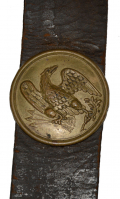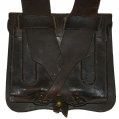site search
online catalog
US MODEL 1857 .69 ROUND BALL INFANTRY CARTRIDGE BOX RIG BY DINGEE WITH SOLDIER’S INITIALS

$1,195.00 SOLD
Quantity Available: None
Item Code: 2024-1383
This is a very good condition, early-war infantry cartridge box rig complete with the sling, both plates, and the magazine tins in place. For details on the various patterns, production numbers and dates, etc., please refer to Paul Johnson’s excellent book, “Civil War Cartridge Boxes of the Union Infantryman.” This box follows the 1857 pattern for the .69 round-ball cartridge as produced by contractors to Federal government delivering to the New York depot from April to December 1861 and is marked on the interior flap by H.A. Dingee of New York who had contracts for at least 1,000 sets of accoutrements for .69 round ball muskets on January 14 and another 1,250 on April 18. Characteristics of these boxes include attachment of the belt loops by stitching alone, with no rivets, positioning the vertical belt loops at the outer inside edge of the horizontal loops, and having the tops of the loops appear to lie on the outside of the outer flap and be sewn. Dimensions of the body of the box follow the specifications as well- roughly 7.2 by 5.8 inches, allowing for some shrinkage, etc.
The color and finish are very good, showing must some fine wrinkles or crazing. The only losses are along the lower back edge from rubbing against the soldier’s body. The latch tab is secured with a single straight line of stitching and is broken across the lower edge of the fastening hole, but the piece is in one of the magazine tin trays. The brass fastening stud on the bottom is in place and as correct for early war boxes shows as more globular than pointed. Both sling buckles are there and correctly attached by stitching only. The implement pouch with its separate flap, latch tab and retaining loop are there. The maker’s name is a light on the left side, but “A. DINGEE” (of H.A. Dingee) and “YORK” of New York can be easily made out. The side ears are present on the inner flap and secure. Both tinned iron magazine tins are there, showing gray from oxidation with the solder a bit lighter, and have the dividers in the upper trays in place.
The original sling is still buckled in place on the bottom of the box and follows the pattern decided on in January 1862, being made bridle leather blackened on the grain side, 2 1/8 inch wide, and pierced with two holes for the round, eagle cartridge box belt plate, which is in place, held by a single, replaced, leather thong. Like the box, the sling has good color and surface, the finish showing a bit brown in tone, with some fine wrinkles and crazing from flexing, with some rubs and some very small flakes, but no large flaked patches or areas.
The sling plate has a pleasing, aged brass patina, matching the box plate. Both have sharp detail. The box plate has one of its two short fastening thongs still in place. The sling plate is correct, but a replacement. The inside of the sling also shows the initials “BH” lightly scratched inside, certainly those of the soldier issued it during the war. For a similar .69 roundball Dingee box, shown from the back, see Johnson, page 99.
This displays very well and would make a great addition to an infantry display or as an accompaniment to a .69 caliber musket firing the round ball, like the percussion converted M1816 muskets or the M1842s in their original un-rifled configurations. [sr] [ph:L]
~~~~~~~~~~~~~~~~~~~~~~~~~~~~~~~~~~~
THIS ITEM, AS WITH ALL OTHER ITEMS AVAILABLE ON OUR WEB SITE,
MAY BE PURCHASED THROUGH OUR LAYAWAY PROGRAM.
CLICK HERE FOR OUR POLICIES AND TERMS.
THANK YOU!
Inquire About US MODEL 1857 .69 ROUND BALL INFANTRY CARTRIDGE BOX RIG BY DINGEE WITH SOLDIER’S INITIALS
For inquiries, please email us at [email protected]
Most Popular
Historical Firearms Stolen From The National Civil War Museum In Harrisburg, Pa »
Theft From Gravesite Of Gen. John Reynolds »
Selection Of Unframed Prints By Don Troiani »
Fine Condition Brass Infantry Bugle Insignia »
Wonderful Condition Original Confederate-Manufactured Kepi For A Drummer Boy Or Child »
featured item
RARE CIVIL WAR “SURGEON’S COMPANION” OR “U.S. ARMY MEDICINE CASE FOR FIELD SERVICE” WITH MASS VOLUNTEER MILITIA MARKINGS, LABEL, AND TINS
This scarce piece of military surgeon’s field gear is in very good condition with both the shoulder and waist belts with buckles full length, in place, and intact, as is the narrower strap buckling over the top to keep the lid closed. This follows… (766-2008). Learn More »















